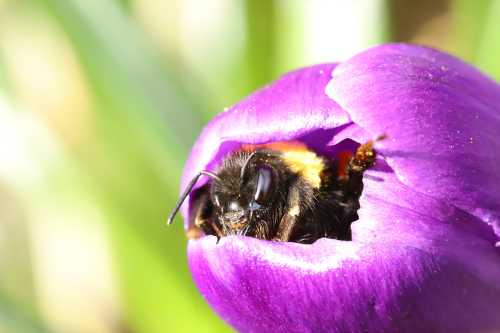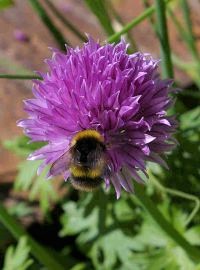Do Honey Bees Forage In Cool Temperatures?
Despite popular misconception that honey bees are only seen on warm days, they can, and do in fact, forage in cool temperatures. Some official sources state they will forage in temperature as low as 54 or 55°F (approximately 12.5°C)1.
Likewise, in chapter 9 of his book, The Lives of Bees2, Professor Thomas D. Seeley describes observations from cooler regions of the world, of thirsty honey bees collecting water in temperatures as low as 39°F (4°C).
However, genetic adaptation may play an important role in tolerance to cool temperatures and suitability to local environment as discussed below.
Why is this question important?
Honey bees are exceptionally important pollinators. Wilson and Messinger-Carrill note in their book Bees In Your Backyard:
"One aspect of honey bee biology that makes them particularly valuable is that they are active primarily on the basis of temperature rather than seasonality the way other bees are.
Honey bees are most active between 60 an 105°F, though they can forage at temperatures as low as 55 °F.
This characteristic makes them valuable pollinators of crops that bloom before many native bees are active.
For example, almond trees in California will flower in February, earlier than most native bees typically emerge, but honey bees will effectively pollinate the almond trees as long as the temperature is warm enough.
The ability of honey bees to forage at such a large range of temperatures means that they are active somewhere in north America during every month of the year."
Personal observations of wild honey bees foraging in cool temperatures
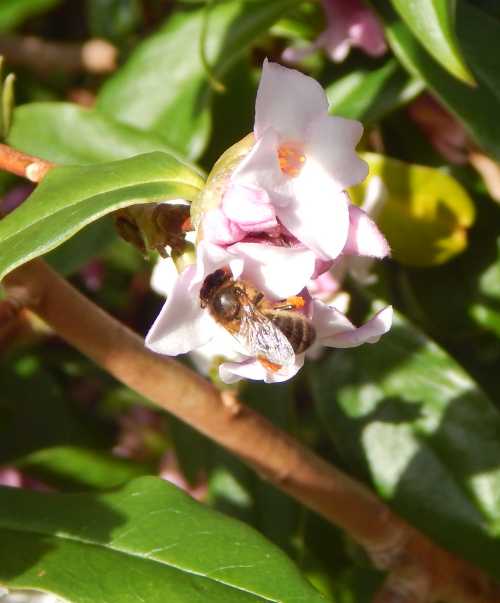 Do honey bees forage in cool temperatures? Yes, the photograph above is of a honey bee foraging on Daphne bholua on January 15th 2020, at a temperature of 8°C (46°F).
Do honey bees forage in cool temperatures? Yes, the photograph above is of a honey bee foraging on Daphne bholua on January 15th 2020, at a temperature of 8°C (46°F).Early in February 2019, my husband and I visited a beautiful garden managed by the National Trust in North Wales, UK.
The weather was bitterly cold, but the sun shone brightly in the sky. It was morning when we arrived and witnessed honey bees foraging on a range of early flowering shrubs (notably Sweet Box - also known as Christmas Box - Sarcococca confusa and Daphne bholua). Both of these winter flowering shrubs have what can only be described as a heavenly, sweet fragrance.
We discovered the bees came from a wild honey bee nest in a tree for which the National Trust created a small sign to inform visitors.
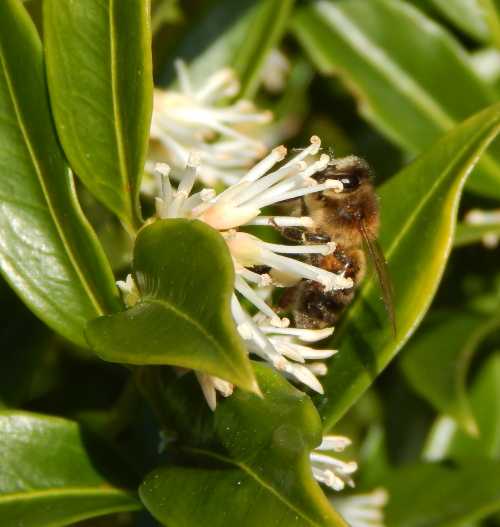 Honey bee foraging on Sweet Box (Sarcococca confusa) on a cool January day in 2020.
Honey bee foraging on Sweet Box (Sarcococca confusa) on a cool January day in 2020.I sometimes read (and had been lead to believe) that bumble bee queens are always seen earlier in the year and in cooler temperatures than honey bees.
However, we saw no bumble bees out and about, and similarly, no solitary bee species were seen either.
Unfortunately I did not have a camera with me, and the only phone we had taken with us was back in the car. However, we managed to get back to the garden later that month on 27th February.
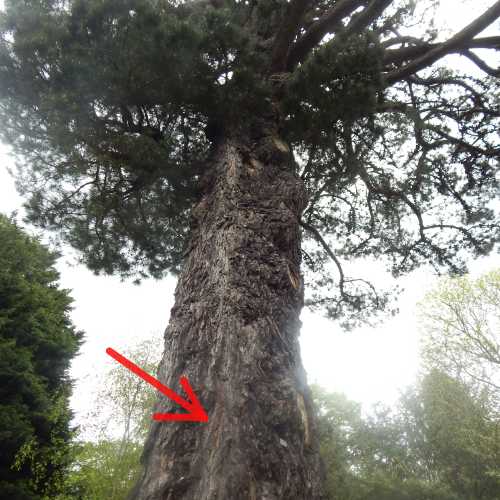 Location of wild honey bee nest
Location of wild honey bee nest
Again we arrived in the morning, the sun was not so bright as the earlier visit. The weather, according to the nearest weather station was 41°F (5°C) and reached 48°F (9°C) by 12 noon. I took photographs and film of the wild honey bee nest in the tree (above).
We observed honey bees primarily visiting Daphne, Erica / heathers, Rhodendron and Mahonia aquifolium.
A few bumble bee queens were also seen and to our surprise, Comma butterflies on the Daphne.
As a consequence of my observations from early last year, I have been especially keen to monitor the progress of the wild honey bee colony, firstly in the hope that it would survive and thrive and secondly, I was genuinely curious as to how early in the season the bees might be seen foraging, and again at what temperature.
Honey bees foraging in January
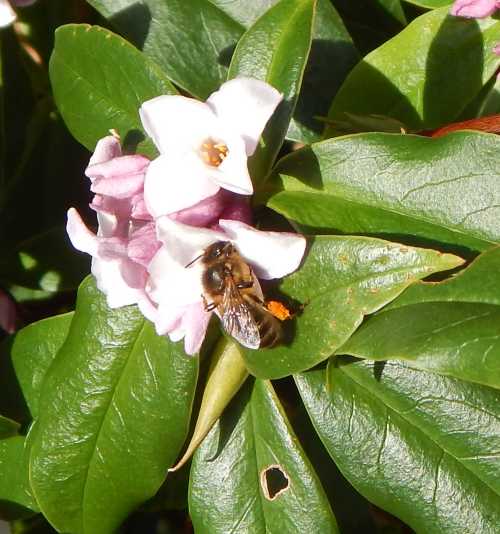 Worker honey bee feeding on fragrant Daphne bholua in January.
Worker honey bee feeding on fragrant Daphne bholua in January.On January 16th 2020, we were able to take a trip back to the beautiful garden to look out for the wild honey bees. We saw them, and we were pleased to observe that the nest was active.
It appeared they were no longer using the original entrance on one side of the tree, and instead had switched to a crevice on the opposite side.
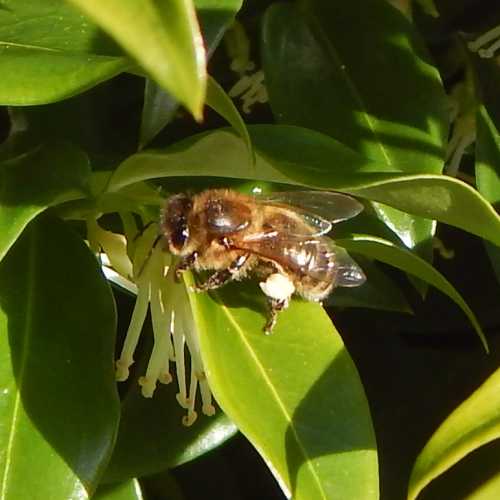 Worker honey bee feeding on fragrant Sarcococca confusa in January.
Worker honey bee feeding on fragrant Sarcococca confusa in January.The official temperature was 8°C (approximately 46°F). As with the visit of the previous year, worker honey bees were observed feeding on fragrant Daphne bholua, and Sarcococca confusa.
No other bees species were seen, and no butterflies either.
Update: March 2021 - Visited the wild colony again. It appeared active and healthy. Honey bees can and do survive in Britain without beekeepers.
Role of honey bee subspecies
Whilst some honey bees may have the ability to forage in especially cool temperatures, for beekeepers it is worth finding out which honey bees are best adapted to thrive in particular geographical locations.
Scientist, beekeeper, author, and world authority on honey bees, Professor Thomas D. Seeley, makes some very important observations with regard to the genetic adaptations in this regard in his brilliant book The Lives Of Bees. Quoted from chapter 11:
"The process of adaptation by natural selection produced the differences in worker-bee color, morphology, and behavior that distinguish the 30 subspecies of Apis mellifera that live within the species' original range of Europe, western Asia, and Africa.
The colonies in each subspecies are well adapted to the climate, seasons, flora, predators, and diseases in their native region of the world. "
It is of course, also worth providing winter flowering plants and shrubs for bees that can also thrive in your particular region.
References
1. University Of Maine: Honeybee Flight Activity Index
2. Thomas D. Seeley, The Lives of Bees: The Untold Story of the Honey Bee in the Wild, Publ. 2019, Princeton University Press, ISBN:9780691166766.
